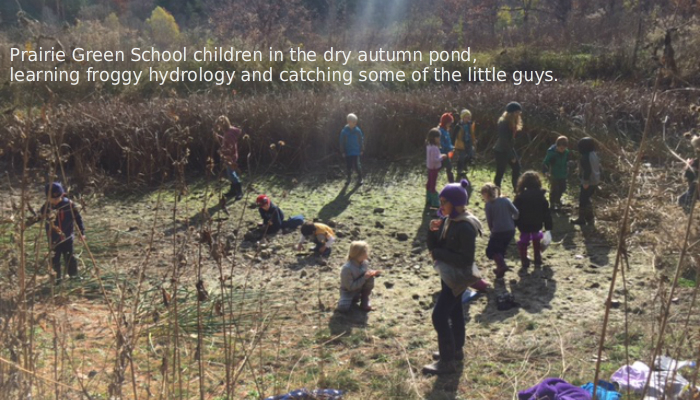A Designer Frog Pond

By Lon Drake
In my part of western Johnson County, we usually encounter seven frog species. Four are little guys – the chorus frog, the cricket frog, and two tree frogs. Two are big guys – the bullfrog and the green frog. And one is an intermediate-size called the leopard frog.
In big ponds with fish, only the big guys survive very well. In small permanent ponds, the bullfrog and sometimes the green frog dominate by eating most of the smaller ones. The big guys’ vulnerability is that their tadpole stage requires two years to mature – in permanent water. So the most successful breeding ponds for the five smaller species are those that regularly hold water during spring and summer, allowing them to mature; but then drying up, preventing the bullfrog and green frog tadpoles from completing their life cycles. Therefore, I designed our “Pine Pond” at home to have this hydrology in most years because the little guys have been hard hit both by the loss of shallow wetlands and also by the proliferation of bass ponds.
This pond is built in moderately leaky silty material. But it is also a rain garden for our rooftop, plus a one-acre watershed, providing a little water from most rains. The pond’s flat bottom and about a foot up the sides were sprinkled with a thin layer of powdered bentonite clay, covered with a huge old blue plastic tarp, and topped with a six-inch layer of large pebbles, which protect the tarp from people and deer who walk in the pond. The tarp in turn keeps the stones from being pushed down into the mud below.
The end product is a pond basin that can temporarily store four feet of stormwater, with the top three feet draining away rather soon, while the bottom foot dissipates slowly enough to still be supplemented by the next rain if it arrives within a week or two.
A dense stand of bur-reeds is just on the south side of the pond and has become a favorite calling place for male frogs as they are somewhat protected even though advertising their location to predators with each call. The north, sun-facing side is kept quite open to facilitate pond warmup, which helps jump-start the frog breeding season and completing their life cycle before the pond dries out.
This pond is only a stone’s throw from our west door, and sometimes on a warm spring night we have trouble sleeping due to the din of calling frogs. So I’ll take my sleeping bag out onto the balcony, shut the house door, and enjoy the chorus.
For a summer view of this same pond, visit my rain garden drama blog: Do You Have a Front Row Seat for Nature’s Productions. Incidentally, the dirt that forms the dam for this pond was scooped from lower on the adjacent mini-watershed, and the created depression was sculpted to form another little ephemeral wetland. Every time modifications are made to the environment, there’s the opportunity to promote habitat and species restoration, especially for those plants and animals that are being otherwise adversely impacted. I hope you keep that in mind with your projects as well!
Tags: frog habitat, Lon Drake, species restoration

